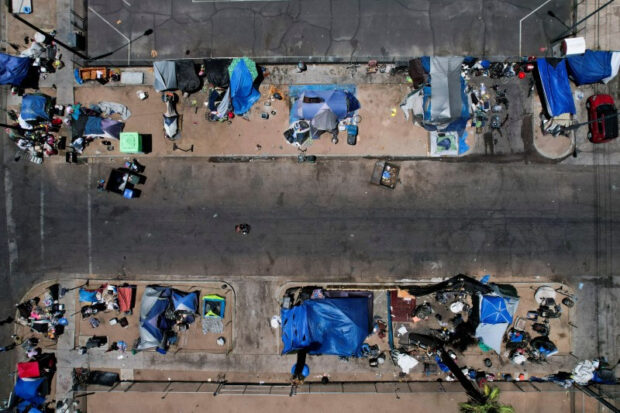In downtown Phoenix, a homeless encampment is receiving much-needed medical care from Circle The City’s mobile medical unit. This comes as the city experiences extreme temperatures, reaching 110 degrees Fahrenheit for 14 consecutive days. Michael Shields, a swimming pool service provider, has developed a strategy to survive the scorching heat, including waking up early, wearing protective clothing, and staying hydrated. However, the current heatwave has surpassed previous records and poses a significant risk to both residents and vulnerable populations like the homeless.
The heatwave is not limited to Phoenix but extends across a large portion of the western and southwestern United States. This is due to a high-pressure dome of air that prevents rain from reaching the affected areas. Phoenix, being situated directly under this dome, has already reached a temperature of 109 degrees Fahrenheit by noon on Saturday, with forecasts predicting a high of 115 degrees Fahrenheit the next day. These extreme temperatures have caused concern among residents, even those accustomed to the summer heat.
According to Climate Check, the number of days with temperatures exceeding 109 degrees Fahrenheit in Phoenix has increased significantly over the years. They estimate that by 2050, residents can expect an average of 44 such days per year. Heat-related deaths in Maricopa County have also been on the rise, emphasizing the need for proactive measures to protect vulnerable individuals.
Efforts to combat the heat include the distribution of bottled water to the homeless and the provision of public cooling stations. The city has also increased the number of volunteers providing essentials like water, hats, and sunscreen. Additionally, plans are in place to offer grants that encourage the planting of more trees to create shade. In terms of recreation, hiking trails and outdoor sports have been limited or postponed to avoid exposing individuals to dangerous temperatures.
While Phoenix residents have become accustomed to hot weather, the long-term warming trend is worrying. The lack of nighttime cooldown and the heat-retaining effects of asphalt and concrete contribute to increasing temperatures. Heat-related illnesses, such as heatstroke, can have severe consequences on health and are a cause for concern.
Meteorologists explain that the current heatwave is not typical, attributing it to a stationary high-pressure air mass that deflects rain and storm systems. This phenomena has affected over 100 million people across the southwestern United States, with Phoenix experiencing some of the most extreme temperatures. The forecast predicts a continuation of these scorching temperatures above 110 degrees Fahrenheit throughout the upcoming week.
Fossil fuel-driven climate change is recognized as a leading factor behind rising temperatures, emphasizing the urgent need to reduce carbon emissions. As the heatwave persists, individuals are taking precautions, such as covering up in protective clothing and avoiding outdoor activities during the hottest hours. The excessive heat has even impacted animals, prompting dog walkers to adjust their routines to prevent their pets from suffering from hot pavement.
In conclusion, the current heatwave in Phoenix and the surrounding areas is a cause for concern, particularly for vulnerable populations. Efforts are underway to provide relief and mitigate the effects of the extreme temperatures, including medical attention, distribution of essentials, and the creation of cooling stations. However, the long-term impact of climate change requires comprehensive actions to combat rising temperatures and ensure the safety and well-being of residents.
Denial of responsibility! VigourTimes is an automatic aggregator of Global media. In each content, the hyperlink to the primary source is specified. All trademarks belong to their rightful owners, and all materials to their authors. For any complaint, please reach us at – [email protected]. We will take necessary action within 24 hours.


